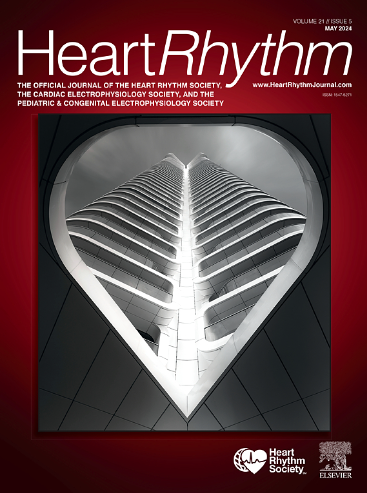Calmodulin kinase II inhibition suppresses atrioventricular conduction by regulating intracellular Ca2+ homeostasis
IF 5.6
2区 医学
Q1 CARDIAC & CARDIOVASCULAR SYSTEMS
引用次数: 0
Abstract
Background
Ca2+/calmodulin-dependent protein kinase II (CaMKII) inhibition decelerates atrioventricular node (AVN) conduction, providing a potential treatment of tachycardia. However, the effectiveness of CaMKII inhibition on tachycardia and its underlying mechanism remains unclear.
Objective
We aimed to assess the effectiveness of CaMKII inhibition in reducing ventricular rates during atrial fibrillation and to elucidate the underlying mechanism in affecting AVN electrophysiology.
Methods
Cardiac CaMKII inhibition (AC3-I) mice were used. Transesophageal atrial pacing was performed to evaluate AVN conduction function and to induce atrial fibrillation. Patch-clamp techniques were employed to record action potentials and ionic currents in AVN cells. Intracellular Ca2+ transients and sarcomere length measurements were obtained with the IonOptix system. Masson trichrome stain was used to evaluate fibrosis in the AVN region. Western blotting and immunofluorescence techniques were employed to detect connexin expression and localization.
Results
CaMKII inhibition decreased the ventricular rate during atrial fibrillation and isoproterenol-induced tachycardia. Esophageal electrocardiogram results from AC3-I mice showed longer AVN conduction than in wild-type mice. AN- and N-type AVN cells from AC3-I mice exhibited slower action potential frequencies and diastolic depolarization rates than those of wild-type mice. The study revealed that CaMKII inhibition reduced AVN cell sarcoplasmic reticulum (SR) Ca2+ content, Ca2+ release rate from the SR during diastole, Ca2+ transient amplitude, and SR Ca2+ uptake rate. In addition, CaMKII inhibition prolonged the sarcomere diastole duration and enhanced the sensitivity of sarcomeres to Ca2+.
Conclusion
CaMKII inhibition effectively decreases the ventricular rate during atrial fibrillation and tachycardia by slowing down AVN conduction through suppressing Ca2+ overload in AVN cells.
钙调蛋白激酶 II 抑制剂通过调节细胞内 Ca2+ 平衡抑制房室传导。
背景:Ca2+/钙调蛋白依赖性蛋白激酶II(CaMKII)抑制可减轻房室结(AVN)的传导速度,为心动过速提供了一种潜在的治疗方法。然而,CaMKII抑制剂对心动过速的疗效及其内在机制仍不清楚:评估抑制 CaMKII 对降低心房颤动时心室率的有效性,并阐明影响房室网电生理学的内在机制:方法:使用心脏CaMKII抑制(AC3-I)小鼠。方法:使用心脏 CaMKII 抑制(AC3-I)小鼠,通过经食管心房起搏评估房室神经传导功能并诱导心房颤动。采用膜片钳技术记录房室神经细胞的动作电位和离子电流。使用 IonOptix 系统测量细胞内 Ca2+ 瞬时值和肌节长度。Masson 三色染色用于评估 AVN 区域的纤维化。采用 Western 印迹和免疫荧光技术检测连接蛋白的表达和定位:结果:抑制 CaMKII 可降低心房颤动和异丙肾上腺素诱发的心动过速时的心室率。AC3-I 小鼠的食管心电图结果显示其房室网传导时间长于野生型(WT)小鼠。与 WT 小鼠相比,AC3-Ⅰ 小鼠的 AN 和 N 型 AVN 细胞表现出更慢的动作电位频率和舒张期去极化率(DRR)。研究发现,CaMKII抑制降低了AVN细胞肌质网(SR)Ca2+含量、舒张期SR的Ca2+释放率、Ca2+瞬态振幅和SR Ca2+摄取率。此外,CaMKII 抑制还延长了肌节舒张时间,并增强了肌节对 Ca2+ 的敏感性:结论:抑制 CaMKII 可通过抑制 AVN 细胞的 Ca2+ 过载而减慢 AVN 传导,从而有效降低心房颤动和心动过速时的心室率。
本文章由计算机程序翻译,如有差异,请以英文原文为准。
求助全文
约1分钟内获得全文
求助全文
来源期刊

Heart rhythm
医学-心血管系统
CiteScore
10.50
自引率
5.50%
发文量
1465
审稿时长
24 days
期刊介绍:
HeartRhythm, the official Journal of the Heart Rhythm Society and the Cardiac Electrophysiology Society, is a unique journal for fundamental discovery and clinical applicability.
HeartRhythm integrates the entire cardiac electrophysiology (EP) community from basic and clinical academic researchers, private practitioners, engineers, allied professionals, industry, and trainees, all of whom are vital and interdependent members of our EP community.
The Heart Rhythm Society is the international leader in science, education, and advocacy for cardiac arrhythmia professionals and patients, and the primary information resource on heart rhythm disorders. Its mission is to improve the care of patients by promoting research, education, and optimal health care policies and standards.
 求助内容:
求助内容: 应助结果提醒方式:
应助结果提醒方式:


